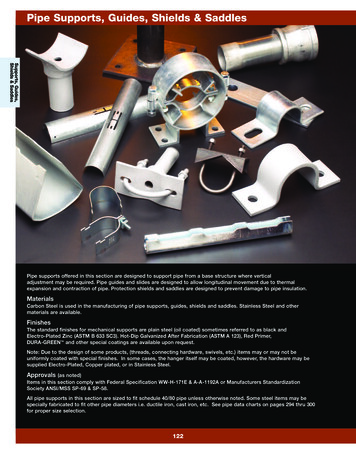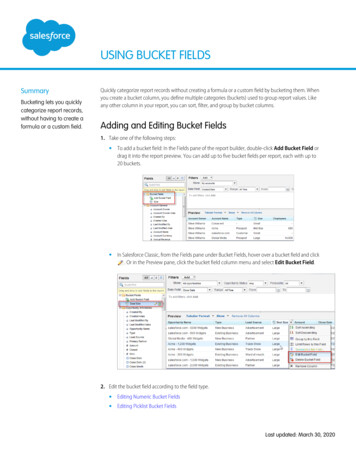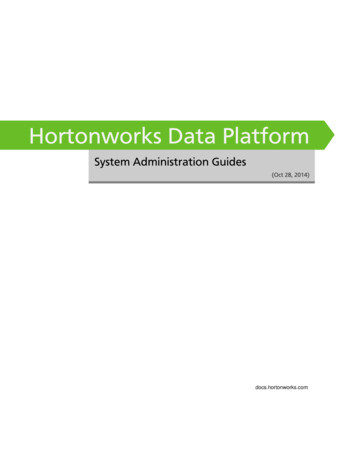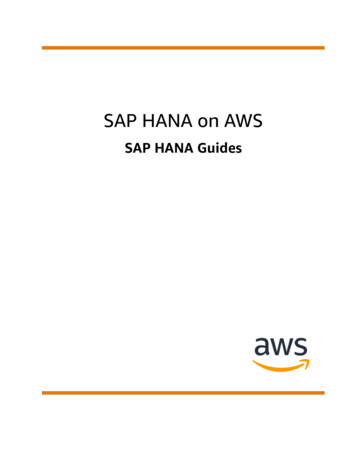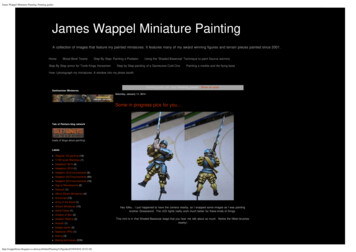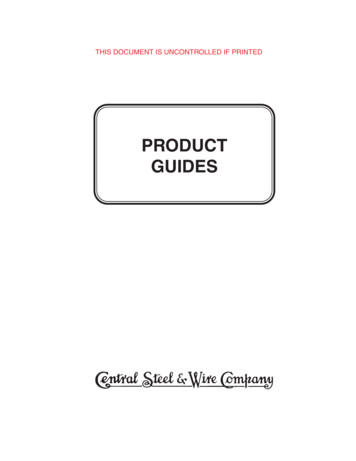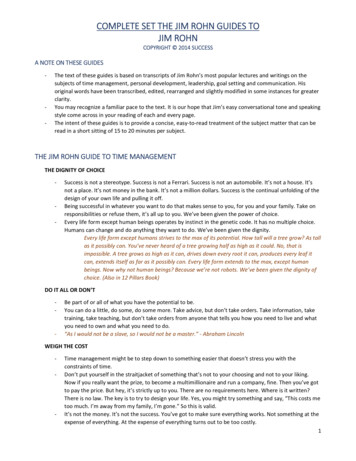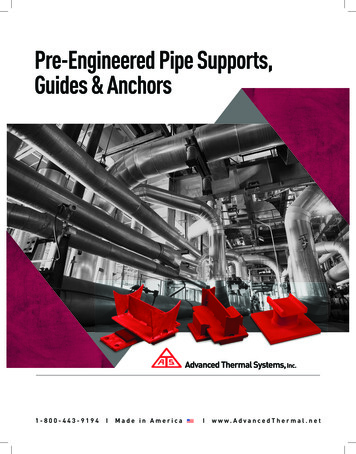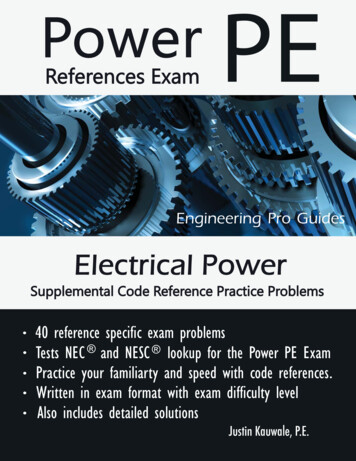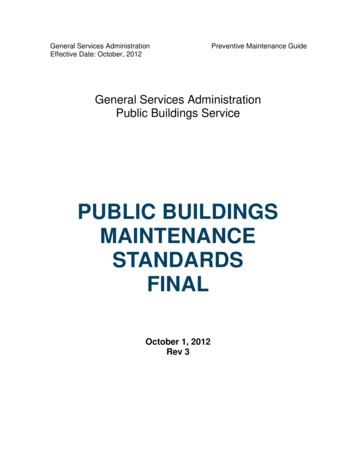
Transcription
General Services AdministrationEffective Date: October, 2012Preventive Maintenance GuideGeneral Services AdministrationPublic Buildings ServicePUBLIC BUILDINGSMAINTENANCESTANDARDSFINALOctober 1, 2012Rev 3
General Services AdministrationEffective Date: October, 2012Preventive Maintenance GuideThis Maintenance Standard is divided into the following Sections:Table of ContentsSECTION 1: INTRODUCTION AND MAINTENANCE STANDARD LIST. 3GENERAL OVERVIEW:. 3MAINTENANCE STANDARD NUMBERS: . 3EQUIPMENT ATTRIBUTES: . 3GOOD MAINTENANCE PRACTICES. 4ELECTRICAL TEST EQUIPMENT. . 5SUITABILITY OF TEST EQUIPMENT. 6TOOLS: . 6SECTION 2: MAINTENANCE STANDARD LISTING . 9Appendix A: NETA Qualifications, Responsibilities and Safety . 656Appendix B: NETA Electrical Test Frequencies . 661Appendix C: Equipment Attributes Lists . 665Appendix D: Maintenance Standard List Key . 678Appendix E RFID Tag Procedures . 694Appendix F: Point Naming Convention . 697Appendix G: Universal Waste Guide (GSA). 703Appendix H: Refrigerant Management Guide (GSA) . 704Appendix I: Underground Storage Tank Regulatory Requirements (GSA) . 705Appendix J: Predictive Maintenance and Toolsets . 706
General Services AdministrationEffective Date: October, 2012Preventive Maintenance GuideGeneral Services AdministrationPublic Buildings ServiceMaintenance Practices and GeneralInformation for Federal BuildingsSection 1: Introduction and Maintenance Standard ListGeneral Overview:The objective of these maintenance standards is to provide helpful instruction inthe performance of preventive and predictive maintenance techniques, in order tomaximize the efficiency of operation and the useful life of equipment, systems, andstructures, and to provide reliable and suitable conditions for the building tenants.They are generic in nature and not intended to substitute for manufacturer'sinstructions or to apply uniformly across all types and configurations of equipmentand systems installed in Federal buildings. Therefore, maintenance staffs andcontractors must exercise a measure of caution in the application of thesestandards.Maintenance Standard Numbers:The GSA Maintenance standard is arranged by sections according to buildingequipment groups or building components. A four (4) tier system is used to easilyidentify the type of building group, equipment type and frequency for performingmaintenance on these systems. The format is as follows:1. Tier 1 identifies the building component system or type of building equipmentgroup, i.e. Electrical (ELEC), Heating Ventilation, Air Conditioning (HVAC)2. Tier 2 identifies the type of equipment, i.e. Transformer (TRN), Chiller (CLR)3. Tier 3 further defines the equipment by number when there is more than onetype, i.e. Centrifugal Chiller (04), Absorption Chiller (05)4. Tier 4 defines the frequency for the specific maintenance task to be performed,i.e. Monthly (01M), Quarterly (03M) Semi-annually (06M), Annually (01Y)The Standard number appears in the format of: HVAC-CLR-04-01Y whichidentifies the standard as: a HVAC System chiller of type 4 (centrifugal) to beperformed annually.Equipment Attributes:Appendix D contains Equipment Attributes lists that the Operations andMaintenance Contractor is required to collect data from each piece of equipment.This task is part of the maintenance requirements for each building in order forGSA to have an accurate and up to date database of each building’s equipment.Equipment is listed with the values and the type of data that shall be collected.
General Services AdministrationEffective Date: October, 2012Preventive Maintenance GuideAttribute fields have been created in the CMMS for each equipment type. Once thedata has been collected it shall be input into the CMMS by the contractor.Good Maintenance PracticesThe following is a list of good practices to observe when performing maintenance.1. Machinery and equipment shall be cleaned and touch up painted asnecessary to restore surface condition and inhibit corrosion.2. Install replacement parts that are appropriate to the equipment, its operatingconditions, and the required performance levels. Substandard componentsshall not be used in government equipment. All parts, materials, components,and replaceable inserts used in the maintenance and repair of equipment andsystems in Federally controlled space shall be new, suitable for the type andseverity of service, and meet safety performance codes and standards.Refurbished parts are not to be used unless approved by proper authority.Normal rework of machinery casings, tube sheets, shafts, and other similartypes of work, where repair to a major structural item is accepted industrypractice, is permitted unless safety and performance are adversely affected.3. Proper documentation through a system of record keeping is required; ifavailable, a Computerized Maintenance Management System (CMMS) shall beused. The types of records authorized may be preprinted government forms orlocally produced forms of an appropriate format. It is paramount to maintainequipment history records to facilitate decision making throughout the life of theequipment. Predictive maintenance frequently entails trending analysis, so ahistory of the test data on the equipment is required.4. The intent of language such as "check", "inspect", etc., is to determine thestatus of the check point item and to take appropriate corrective action toeliminate any deficiencies found on the spot if within contract limits if possibleand or to notify GSA as soon as practicable when repair exceeds contractlimits or cannot be repaired on the spot. If additional calibration, adjustment,replacement of parts and fluids, and other work are necessary, that work shallbe accomplished or scheduled for future action.5. Maintenance work shall be scheduled so as to minimize the disruption tobuilding occupants and operations. Proper notification and coordination shallbe made when maintenance work necessitates shutting down equipment orotherwise terminating services to the building occupants.6. Equipment under warranty shall be maintained in accordance with warrantyinstructions and conditions. Warranty provisions will be stringently compliedwith during the periods that they apply.7. When fixed fire protection systems are temporarily removed or disconnectedfrom service, they must be reconnected and/or placed back into service at theend of each work day unless otherwise authorized. Fixed fire protection
General Services AdministrationEffective Date: October, 2012Preventive Maintenance Guidesystems include equipment and devices whose function is to prevent, detect, orcontrol fires, or transmit signals related to fire emergencies. The status of majorequipment or systems not operating or that become non operational during theworkday, or any system or equipment item, including elevators, not operationalby the official working hours start time, shall be reported to the proper authority(buildings manager or contracting officer's representative.) Security and firealarm system malfunctions must be reported immediately to the GSA callcenter. All fire related equipment operation and maintenance shall follow theappropriate National Fire Protection Association (NFPA) code or standard,such as NFPA 72 the National Fire Alarm Code.8. When performing maintenance on equipment that requires working with(CFC’s) refrigerants. Those working on the equipment must maintain theapplicable certifications for working on such equipment. All applicable local,state, federal guidelines and regulations must be adhered to with respect todocumentation, handling and disposal of refrigerants.9. When performing maintenance in space that may be occupied or accessibleduring the performance of the work, provide adequate steps for the protectionof the public and employees.10. Trash, debris, and wastes from contract work inside buildings shall be removeddaily. Exceptions shall be approved in advance. Premises shall be left neat andclean after each work shift so that the Government business can proceedwithout interruption the next regular workday. All waste material shall beproperly disposed of in accordance with applicable Federal, State and localregulations.11. All equipment and systems shall be maintained at a level, fair wear and tearexcepted, to assure that the building(s) are operated in an efficient andeconomical manner.12. All work, including contact with and handling of hazardous materials andwastes, the disturbance or dismantling of structures or equipment containinghazardous materials and/or the disposal of ordinary and hazardous materialsand wastes shall comply with applicable Federal requirements including 29CFR 1910/1926, 40 CFR 260-265, 40 CFR 61, 49 CFR 171-179, andapplicable state and municipal safety and environmental requirements. Submitcopies of permits, certificates, and manifests that indicate hazardous waste hasbeen disposed of in compliance with the regulations. Where there is a conflictbetween applicable regulations, the most stringent shall apply.Electrical test equipment.All electrical test equipment shall conform to the following requirements, outlined inANSI/NETA MTS-2011.
General Services AdministrationEffective Date: October, 2012Preventive Maintenance GuideSuitability of Test Equipment1. All test equipment shall meet the requirements in paragraph b) TestInstrument Calibration and be in good mechanical and electrical condition.2. Field test metering used to check power system meter calibration must bemore accurate than the instrument being tested.3. Accuracy of metering in test equipment shall be appropriate for the test beingperformed.4. Wave shape and frequency of test equipment output waveforms shall beappropriate for the test to be performed and the equipment to be tested.5. Test Equipment calibrationa)The testing organization shall have a calibration program whichassures that all applicable test instruments are maintained within ratedaccuracy for each test instrument calibrated.b)The firm providing calibration service shall maintain up-to-dateinstrument calibration instructions and procedures for each testinstrument calibrated.c)The accuracy shall be directly traceable to the National Institute ofStandards and Technology (NIST).d)Instruments shall be calibrated in accordance with the followingfrequency schedule:i.Field instruments: analog and digital, 12 month maximum.ii.Laboratory instruments: 12 month maximum.iii.Leased specialty equipment: 12 month maximum.e)Dated calibration labels shall be visible on all test equipment.f)Records which show date and results of instruments calibrated ortested must be kept up to date.g)Calibrating standard shall be of better accuracy than that of theinstrument tested.Tools:The following tool groups are referenced within this standard. The lists serve asguides for supplying maintenance personnel with tools. Basic and trade toolsrequired will vary depending on equipment served and on individual preferences.Special recommended tools, materials, and equipment are listed in the individualstandards as required.STANDARD TOOLS - BASIC(All Trades)
General Services AdministrationEffective Date: October, 2012Preventive Maintenance Guide1. Standard and Phillips head screw drivers-various sizes.2. Pliers-vise grip (2), slip-joint, needle-nose, diagonal,3. cutting pliers, side cutters.4. Ball peen hammer.5. Hack saw and spare blades.6. 3/8' drive socket set and ratchet.7. Small set of Allen wrenches.8. Assorted center punches, drift punches, and steel chisel.9. 12' measuring tape.10. Crescent wrenches 4" to 8".11. Open and box end wrenches ¼" to ¾".12. File.13. Pipe wrenches to 14".14. Small level and square.15. Pocket knife.16. Flashlights.17. Grease guns and oilers18. Wire brush.19. Extension cord and inspection lights.20. Various cleaning tools - brushes, scrapers, etc.21. Emery cloth.TOOL GROUP A1. Standard tools - basic2. Refrigeration - gauges3. Leak detector-electronic or halogen4. Pocket thermometer5. Clamp on meter (volt - ohm - amp meter)6. Flaring tool7. Tubing cutters
General Services AdministrationEffective Date: October, 2012Preventive Maintenance Guide8. Packing kit and packing9. Crescent wrenches to 14"TOOL GROUP B1. Standard tools - basic2. Insulated pliers and screwdrivers3. Wire strippers4. Wire crimpers5. Voltmeter - Ohmmeter - Milliammeter6. Clamp on meter(volt - ohm - amp meter)7. Soldering kit8. 1/8" 25' fish tape9. Burnishing toolTOOL GROUP C1. Standard tools - basic2. Pipe wrenches to 24"3. Tubing cutters4. Flaring tool5. Small acetylene outfit6. Packing tool kit and packing7. ¾" socket set8. Crescent wrenches to 14"
General Services AdministrationEffective Date: October, 2012Preventive Maintenance GuideSection 2: Maintenance Standard ListingGeneral ServicesAdministrationMAINTENANCE TIME STANDARDSStandard #Equipment ItemARCHITECTURAL AND STRUCTURALARCS-BAR-01-06MSecurity Bollards and , Power OperatedARCS-DOR-02-03MDoor, Hydraulic, Electric or Pneumatic OperatedARCS-DOR-03-06MDoor, Manual, OverheadARCS-DOR-04-06MDoor, Main ineratorARCS-LND-01-06MFountain, Memorial or DecorativeARCS-LND-02-06MGates and Fences, Security and AccessARCS-LND-03-01YLawn Sprinklers (per nozzle)ARCS-LND-04-03MFlag Pole, Electric and ManualARCS-LND-05-06MLawn Mower and EdgerARCS-MHL-01-01YManhole, ElectricalARCS-MHL-02-03MManhole, SewerManhole, Water/Steam/Fuel Oil (also includes hotARCS-MHL-03-06Mwater, chilled water, and condenser water)Roof Inspection - Built-up type (per square, or 100ARCS-RFS-01-06Msq. ft.)ARCS-RFS-02-06MRoof Inspection - Shingle Type (per 100 sq. ft.)ARCS-RFS-03-03MExtensive and Intensive Vegetative RoofARCS-SCT-01-03MKey Card SystemARCS-SCT-02-01YParking Arm GatesARCS-STR-01-01YLightning Protection (per down conductor)ARCS-SWM-01-01MStorm Water Management: Ponds (Dry and Wet)ARCS-SWM-02-01MStorm Water Management: BasinsARCS-SWM-03-01MStorm Water Management: TrenchesARCS-SWM-04-01MStorm Water Management: Dry WellsARCS-SWM-05-01MStorm Water Management: Permeable PaversStorm Water Management: Hydrodynamic StructuresARCS-SWM-06-01M(i.e. swales)ARCS-SWM-07-01MStorm Water Management: BiofiltrationARCS-WIN-01-01YWindow Washing Scaffold, Power OperatedOffice of Real PropertyManagement hlyAnnuallyOct-1
General Services AdministrationEffective Date: October, 2012Preventive Maintenance GuideGeneral ServicesAdministrationMAINTENANCE TIME STANDARDSStandard #Equipment ItemCHILD 1YOffice of Real PropertyManagement andSafetyEffectiveDateFrequencyChild Care EquipmentChild Care Secured Perimeter SystemsChild Care AreasOct-1Oct-1Oct-1MonthlyMonthlyMonthlyScrubbing Machine, Battery or Propane PoweredSnow BlowerSweeperTrash CompactorVacuum Cleaner, Heavy Duty, Tank TypeVacuum System, BAS ServerBAS ServerBAS ServerBAS ServerBAS Server Client WorkstationBAS Server Client WorkstationBAS Server Client WorkstationBAS Server Client WorkstationNetwork, Management LevelNetwork, Management LevelNetwork, Building LevelNetwork, Building LevelField PanelControllerControls, Sensors ElectronicAlarm MaintenanceBAS Wireless Electronic/Pneumatic End Devices(Thermostats)BAS Wireless Electronic/Pneumatic End Devices(Thermostats)End DevicesControl Air SystemReceiver ControllerFilter, Control lyAutomatic Transfer Switch, per NFPA 110Automatic Transfer SwitchMetal-Enclosed Busways, Thermographic SurveyOct-1Oct-1Oct-1MonthlyAnnuallyAnnually
General Services AdministrationEffective Date: October, 2012Preventive Maintenance GuideGeneral ServicesAdministrationMAINTENANCE TIME STANDARDSStandard #Equipment ItemOffice of Real PropertyManagement YELEC-CBL-01-01YELEC-CBL-01-03YMetal-Enclosed BuswaysCapacitors, Thermographic SurveyCapacitorsReactors-Dry-Type, Thermographic SurveyReactors – Dry-TypeReactors – Liquid-Filled, Oil LeakageReactors – Liquid-Filled, Oil SamplingReactors – Liquid-FilledCables, Low-Voltage, Thermographic SurveyCables, m- and High-Voltage Cables, 1-03MELEC-LTG-02-02YMedium- and High-Voltage CablesCircuit Breakers, Air, Insulated-Case/Molded-CaseCircuit Breakers, Air, Insulated-Case/Molded-CaseCircuit Breakers, Air, Low-Voltage PowerCircuit Breakers, Air, Low-Voltage PowerCircuit Breakers, Air, Medium-VoltageCircuit Breakers, Air, Medium-VoltageCircuit Breakers, Oil, Medium- and High-VoltageCircuit Breakers, Oil, Medium- and High-VoltageCircuit Breakers, Oil, Medium- and High-VoltageCircuit Breakers, Vacuum, Medium-VoltageCir
Oct 01, 2012 · Public Buildings Service Maintenance Practices and General Information for Federal Buildings Section 1: Introduction and Maintenance Standard List General Overview: The objective of these maintenance standards is to provide helpful instruction in the performance of prev
